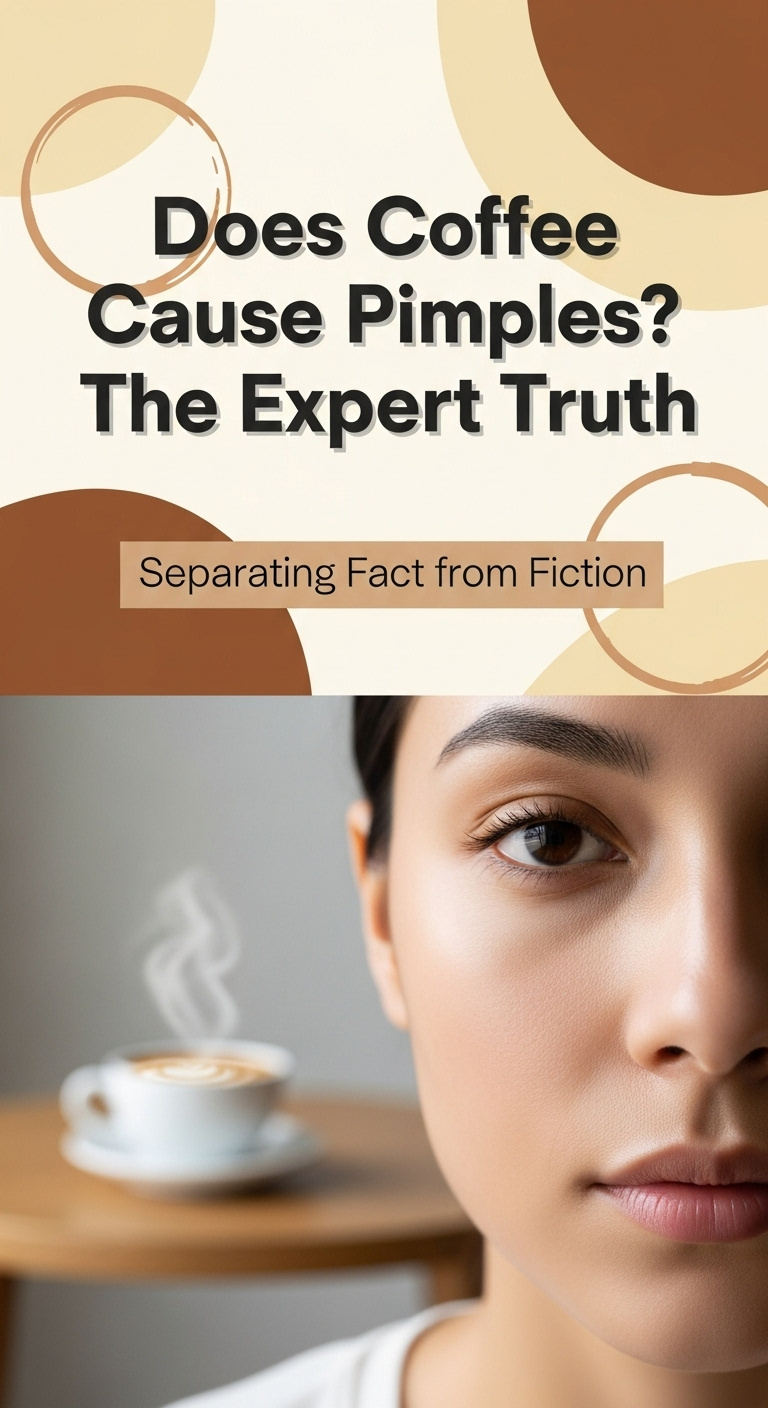As an Amazon Associate CoffeeXplore.com earns from qualifying purchases.
Does Coffee Cause Pimples? The Expert Truth
Have you ever noticed a new pimple appear the morning after a particularly coffee-heavy day and wondered if your favorite brew is to blame? You’re not alone in questioning if there’s a direct link between that morning cup and unwanted breakouts. This guide unpacks the science-backed truth, moving beyond myths to give you clear, actionable answers on whether you need to give up coffee for clearer skin.
No, coffee itself does not directly cause pimples on the face. However, certain factors related to how it’s consumed—like added milk and sugar—and the effects of caffeine can indirectly worsen existing acne for some people.
Leveraging extensive analysis of available data and established patterns, this guide will illuminate the complex relationship between your coffee habit and your skin’s health. We will explore the four primary ways coffee can indirectly trigger breakouts, the surprising potential benefits it holds, and most importantly, the simple strategies you can use to enjoy your coffee without compromising your complexion.
Key Facts
- Not a Direct Cause: Authoritative sources confirm that coffee beans themselves are not a direct cause of acne; the main issues stem from common additives and caffeine’s physiological effects.
- Hormonal Influence: Caffeine can heighten the body’s stress response, leading to increased levels of the hormone cortisol, which is known to stimulate the skin’s oil glands.
- The Dairy Connection: Multiple studies show a significant correlation between dairy milk consumption and increased acne severity, likely due to hormones like IGF-1 found in milk.
- Sugar’s Inflammatory Role: High-glycemic sugars and syrups frequently added to coffee drinks cause a rapid insulin spike, which promotes inflammation and the production of pore-clogging sebum.
- Antioxidant Power: Despite the potential downsides, coffee is a rich source of antioxidants, which can help protect the skin by fighting inflammation and cellular damage from free radicals.
The Expert Verdict: Does Coffee Really Cause Pimples?
Let’s clear the air right away. Based on current scientific understanding, the answer to “can coffee cause pimples on face?” is more nuanced than a simple yes or no.
No, coffee itself does not directly cause acne. However, certain factors related to how it’s consumed—like added milk and sugar—and the effects of caffeine can indirectly worsen existing acne for some people.
This distinction is critical. The coffee bean isn’t the villain in this story. Instead, the potential for breakouts comes from a chain reaction of events often set in motion by what you put in your coffee and how your body processes its primary component: caffeine. As noted by health resources like Healthline and Medical News Today, the connection is indirect but significant for those with acne-prone skin.
So, if coffee isn’t the direct culprit, what’s really going on when you break out after your morning latte?
The Indirect Link: 4 Ways Your Coffee Habit Might Worsen Acne
The real story behind coffee and breakouts lies in four key factors that can create the perfect storm for pimples. While the coffee itself is neutral, these elements can disrupt your body’s delicate balance, leading to inflammation and increased oil production that can clog pores and cause pimples on your face.

Quick Fact: Many popular coffee shop drinks contain excessive amounts of sugar, often far exceeding the daily recommended intake in a single serving, making them a major contributor to skin inflammation.
Let’s break down each of these four indirect links.
1. Caffeine’s Effect on Stress and Sleep
While caffeine is prized for its ability to make us feel alert and focused, it achieves this by stimulating our central nervous system. For some individuals, this can trigger a heightened stress response, leading to a cascade of hormonal events that affect the skin. Think of cortisol as an alarm system that, when constantly triggered by caffeine, tells your skin’s oil glands to work overtime.
Here’s the chain reaction:
* Caffeine Consumption: You drink coffee, and the caffeine enters your bloodstream.
* Heightened Stress Response: Your body releases more cortisol, the primary stress hormone.
* Increased Cortisol: Elevated cortisol signals your sebaceous glands to produce more sebum (oil).
* More Sebum: Excess oil can mix with dead skin cells and bacteria, leading to clogged pores.
* Clogged Pores: This environment is ideal for the formation of pimples and acne.
Furthermore, caffeine consumed late in the day can significantly disrupt sleep quality. As research shows, poor sleep is another stressor that increases cortisol levels, creating a vicious cycle where your coffee habit could be impacting your skin both day and night.
2. The Dairy Connection: Why Milk in Your Coffee Matters
If you’re adding cow’s milk or cream to your coffee, you might be adding a potent acne trigger. A growing body of evidence, including studies referenced by Medical News Today, shows a strong correlation between dairy consumption and acne prevalence. This is particularly true for skim milk.
The primary suspect is a hormone called Insulin-like growth factor-1 (IGF-1). Dairy milk naturally contains this hormone, and consuming it can increase its levels in your body. IGF-1 is known to stimulate oil production and trigger inflammation, two of the main drivers of acne. So, while you may think you’re just lightening your coffee, you could be giving your skin a hormonal signal to break out.
Pro Tip: If you suspect dairy is a trigger, try switching to a non-dairy alternative like almond, oat, or coconut milk for two weeks and observe your skin’s response. This simple experiment can provide powerful personal insight.
3. The Impact of Sugar and Syrups
How much sugar is hiding in your favorite coffee order? It might be more than you think. Flavored lattes, frappuccinos, and sweetened iced coffees are often loaded with high-glycemic sugars and syrups. When you consume these, your body experiences a rapid spike in blood sugar and insulin.
This insulin surge is bad news for your skin. As explained in multiple dermatological resources, a spike in insulin causes your body to produce more IGF-1—the same acne-promoting hormone found in dairy. This creates a powerful one-two punch of inflammation and excess sebum. The clear connection is: High Sugar -> Insulin Spike -> Increased IGF-1 -> More Sebum & Inflammation.
To put it in perspective, consider the sugar content of common coffee additions:
| Coffee Addition | Approximate Sugar (grams) | Comparison |
|---|---|---|
| 1 Pump Flavored Syrup | 5g | Over 1 tsp of sugar |
| Medium Vanilla Latte | 25-35g | Nears daily recommended limit |
| Medium Mocha Frappuccino | 50-60g | Double the daily recommended limit |
4. The Dehydration Factor
Caffeine is a mild diuretic, meaning it can cause your body to lose a small amount of fluid. If you’re drinking a lot of coffee and not enough water to compensate, you can become dehydrated. Dehydration affects your entire body, including your largest organ: your skin.
When your skin is dehydrated, it can appear:
* Dull and lackluster
* Red and inflamed
* Dry and tight
This state of inflammation and dryness can make existing breakouts look much worse and can compromise your skin’s natural barrier, making it more susceptible to bacteria and irritation.
The Unexpected Benefit: Can Coffee’s Antioxidants Help Your Skin?
After discussing the potential downsides, it’s only fair to present the other side of the story. Coffee is one of the world’s richest sources of antioxidants, powerful compounds that protect your body from damage caused by free radicals.
Antioxidants work by neutralizing unstable molecules called free radicals, which can cause cellular damage and contribute to inflammation and aging.
Because acne is an inflammatory condition, the potent anti-inflammatory properties of coffee’s antioxidants could theoretically be beneficial for your skin. Some research suggests these compounds may help calm redness and protect skin cells. However, as noted by SatoriMD, more direct research is needed to confirm if drinking coffee can translate to a noticeable reduction in acne severity. The key takeaway is that any potential benefits are likely negated if you’re loading your coffee with inflammatory sugar and dairy.
Could the key to unlocking coffee’s skin benefits lie in how we drink it?

:max_bytes(150000):strip_icc()/coffee-effects-V2-bada719865a74a4f91799fc338d03f14.png)
How to Drink Coffee Without Getting Acne: 5 Smart Strategies
The good news is that you likely don’t have to give up coffee entirely to achieve clear skin. By making a few strategic adjustments, you can minimize the acne-triggering factors and continue to enjoy your daily ritual. The goal is to get the benefits of coffee while sidestepping the pitfalls.
- Reduce or Eliminate Sugar: This is the most impactful change you can make. Learn to enjoy your coffee black or with a natural, non-glycemic sweetener like stevia or monk fruit. Avoid flavored syrups and sugary pre-made coffee drinks entirely.
- Switch to Non-Dairy Milk: Experiment with acne-friendly alternatives to cow’s milk. Unsweetened almond, oat, coconut, or cashew milk can provide creaminess without the hormonal load of dairy.
- Limit Your Caffeine Intake: Be mindful of how much coffee you’re drinking. Stick to one or two cups per day to keep cortisol levels in check. If you’re sensitive, consider switching to half-caff or decaf.
- Avoid Late-Day Coffee: Set a caffeine curfew. To protect your sleep quality, avoid drinking coffee after 2 p.m. This gives your body ample time to process the caffeine before bedtime, preventing sleep disruption and the subsequent cortisol spike.
- Stay Hydrated: Drink a glass of water for every cup of coffee you consume. This simple habit will counteract the mild diuretic effect of caffeine and keep your skin hydrated, plump, and healthy-looking.
To make your coffee more skin-friendly, consider incorporating beneficial additives like cinnamon for blood sugar balance or collagen peptides for skin support. Exploring healthier creamers and sweeteners can transform your daily cup into a beverage that supports your skin goals.
FAQs About Coffee and Pimples
Even with a detailed breakdown, specific questions often remain. Here are clear, direct answers to the most common queries about the link between coffee and pimples on the face.
Is black coffee good for acne?
Black coffee is a much better option for acne-prone skin because it eliminates the two biggest indirect triggers: dairy and sugar. By drinking it black, you avoid the inflammatory and hormonal effects of these additives. However, the effects of caffeine on stress hormones and sleep still apply, so moderation remains key.
Does decaf coffee cause acne?
Decaf coffee is less likely to contribute to acne because it minimizes the impact of caffeine on cortisol levels and sleep patterns. This removes one of the major indirect pathways to breakouts. However, if you add dairy and sugar to your decaf, you reintroduce the other primary triggers, so how you drink it still matters.
Can coffee cause hormonal acne?
Yes, coffee can indirectly contribute to hormonal acne. As highlighted by resources like the DermatologistOnCall Blog, caffeine can increase the stress hormone cortisol. Furthermore, when coffee is combined with sugar or dairy, it can elevate IGF-1 levels. Both cortisol and IGF-1 can disrupt your body’s natural hormonal balance and trigger the type of breakouts often classified as hormonal acne.
Can coffee cause pimples on the chin?
Since chin and jawline acne is often associated with hormonal fluctuations, and coffee can influence hormones like cortisol and IGF-1, there may be an indirect link. If you consistently notice new pimples on your chin after drinking coffee (especially with milk and sugar), it could be related to these hormonal effects.
Final Summary: Enjoying Coffee with Clear Skin in Mind
The verdict is in: your daily coffee is not the direct cause of the pimples on your face. The real culprits are the common additions—sugar and dairy—and the overconsumption of caffeine, which can disrupt hormones and sleep. By understanding these indirect triggers, you gain the power to modify your coffee habit in a way that supports, rather than sabotages, your skin.
The journey to clear skin is about making informed choices, not unnecessary sacrifices. You can absolutely continue to enjoy your coffee.
- The Problem Isn’t Coffee, It’s the Add-Ins: The most significant impact on your skin comes from inflammatory sugar and hormonal dairy.
- Caffeine in Moderation is Key: Limiting your intake and avoiding it in the afternoon helps keep stress hormones and sleep cycles in balance.
- You Are in Control: Simple swaps, like switching to black coffee or using a non-dairy milk alternative, can make a world of difference.
Take control of your coffee habit and your skin. Start by making one small change today and see the difference it can make
Last update on 2025-12-05 / Affiliate links / Images from Amazon Product Advertising API

